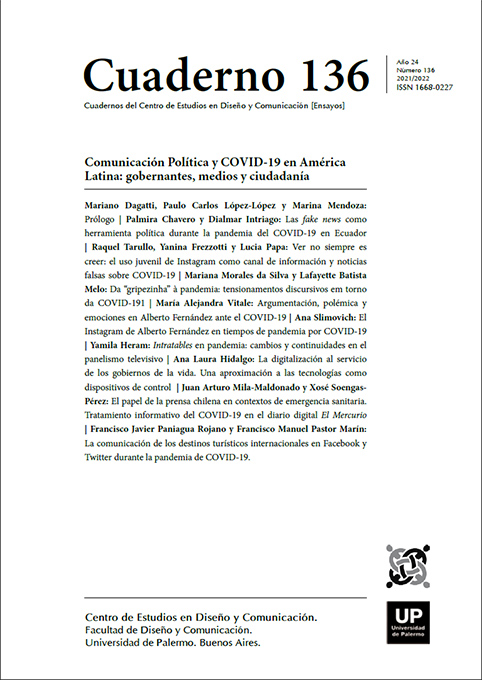Las fake news como herramienta política durante la pandemia del COVID-19 en Ecuador
Abstract
The theoretical debate about fake news has regained prominence from the generalization of the use of new technologies, especially digital social networks and from the intentional perspective in the dissemination of this type of content. Within this debate, this work starts from the proposal that the concept of fake news is a discursive expression used by politicians when their legitimacy is affected (Wardle and Derakhshan, 2017). Based on this proposal, and on the premise that in the Ecuadorian case, fake news became a political tool to hide the true crisis, we conducted a content analysis of the information that the government showed as verified fake news, in order to identify the characteristics of the government's communication strategy during the first two months of the pandemic.
References
Aguaded, I. y Romero, L. (2015). Mediamorfosis y desinformación en la infoesfera: Alfabetización mediática, digital e informacional ante los cambios de hábitos de consumo informativo. Education in the Knowledge Society (EKS) 16 (1), 44-57. Disponible en: https://revistas.usal.es/index.php/eks/article/view/eks20151614457/12983
Aguilar, D. y Said, E. (2010). Identidad y subjetividad en las redes sociales virtuales: caso de Facebook”. Zona Próxima: Revista del Instituto de Estudios en Educación Universidad del Norte, nº 12 pp: 190-207. Disponible en: http://rcientificas.uninorte.edu.co/index.php/zona/article/viewFile/1145/725
Amadeo, B. (2016). “El Estudio De La comunicación Gubernamental: Líneas De investigación Y Futuros desafíos”. Austral Comunicación 5 (2), 155-81.
Berelson, B. (1952). Content analysis in Communication Researches. Free Press, Glencoe III.
Bernal-Triviño, A y Clares-Gavilán, J. (2019). “Uso del móvil y las redes sociales como canales de verificación de fake news. El caso de Maldita.es”. El profesional de la información 28 (3).
Calvo, E y Aruguete, N. (2020). Fake news, trolls y otros encantos (para bien y para mal) las redes sociales. Buenos Aires: Siglo XXI.
Chavero, P. (2020). De la disputa a la colaboración mediático-política en Ecuador. Análisis comparado de los frames mediáticos en las protestas de 2015 y 2019. Cuaderno 112. pp 35-49.
Coombs, W. (2007). “Protecting Organization Reputations During a Crisis: The Development and Application of Situational Crisis” Communication Theory. Corp Reputation Rev 10, 163–176.
Cortes, C. e Isaza, L. (2017). Noticias falsas en Internet: la estrategia para combatir la desinformación. Centro de Estudios en Libertad de Expresión y Acceso a la Información (CELE). Disponible en: https://www.palermo.edu/cele/pdf/FakeNews.pdf
Edson C., Tandoc Jr., Zheng Wei Lim y Richard Ling. (2017). Defining “Fake News”: A typology of scholarly definitions. Digital Journalism, 6:2, 137-153.
Fernández, Á. (2014). “La expansión del rumor en los medios digitales”. En F. Sabés, F. y J.J. Verón (Eds.). Universidad, Investigación y Periodismo digital (pp.19-36). Aragón: Asociación de Periodistas de Aragón.
Jenkyns, H. (2006). Convergence Culture. Barcelona España. Editorial Paidós Ibérica.
Lazer, D.; Baum, M.; Benkler, Y.; Berinsky, A.; Greenhill, K.; Menczer, F. Metzger, M.; Nyhan, B.; Pennycook, G.; Rothschild, D.; Schudson, M.; Sloman, St; Sunstein, C.; Thorson, E.;
Watts, D.; Zittrain, J. (2018). “The science of fake news”. Science 359 (Issue 6380), pp. 1094-1096. Disponible en: https://science.sciencemag.org/content/359/6380/1094
Lobo, S. (2017). “Cómo influyen las redes sociales en las elecciones”. Revista Nueva Sociedad, 269, pp: 40-44. Disponible en: https://nuso.org/media/articles/downloads/1.TC_Lobo_269.pdf
Losada, R. (2020). “Las fake news en las crisis de la sociedad digital”. Más poder local. Nº. 41, pp. 48-50.
Noguera, F. (2009). “La Campaña Permanente”, en Izurieta, Roberto; Perina, Rubén; Arterton, Christopher (compiladores); Estrategias de Comunicación para Gobiernos. Buenos Aires: Ediciones La Crujía.
Requena, F. (1989). El concepto de red social. REIS: Revista Española de Investigaciones Sociológicas, Nº 48, pp. 137-152. Disponible en: http://www.reis.cis.es/REIS/PDF/REIS_048_08.
Riorda, M. (2011). La Comunicación Gubernamental como Comunicación Gubernamental. Politai 2 (3), pp. 96-111. Disponible en: http://revistas.pucp.edu.pe/index.php/politai/article/view/13956
Riorda, M. (2012). “Quiero salir...sólo y si se puede, bien”. Más poder local, Nº. 10, pp. 38-40. Disponible en: https://dialnet.unirioja.es/servlet/articulo?codigo=3912684
Rodríguez, C. (2019). “No diga fake news, di desinformación: una revisión sobre el fenómeno de las noticias falsas y sus implicaciones”. Comunicación, Nº. 40, pp. 65-74.
Rojas, O. (2003). La comunicación en momentos de crisis. Comunicar, Revista Científica de Comunicación y Educación, pp. 137-140.
Ros-Martín, M. (2009). “Evolución de los servicios de redes sociales en internet”. El Profesional de la Información 18 (5), pp. 552-557. Disponible en: https://recyt.fecyt.es/index.php/EPI/article/view/epi.2009.sep.10/21581
Saura Pérez, P; García García, F. (2012). “La comunicación de crisis como elemento clave de la comunicación empresarial”. Revista ICONO14 Revista Científica De Comunicación Y Tecnologías Emergentes 8 (2), 42-56.
Velasco, M. (2013). Redes sociales, lo público y lo político en construcción. Chasqui 121, pp 81-87. Disponible en: http://hdl.handle.net/10469/13279
Wardle, C. (2017). “Fake news. It's complicated”. First Draft. Disponible en: https://medium.com/1st-draft/fake-news-its-complicated-d0f773766c79
Wardle, C; Derakhshan, H. (2017). “Information Disorder.” Reporte de Consejo Europeo DGI. Disponible en: https://rm.coe.int/information-disorder-toward-an-interdisciplinary-framework-for-researc/168076277c
Van Dijk T. (1999). “El análisis crítico del discurso”. Anthropos (186), septiembre-octubre, pp. 23-36.
Vixtha Vázquez, F. (2017). “Interactividad y Multimedialidad: elementos que la Hipermediación aporta a la Comunicación Educativa”. Razón y Palabra 21 (98), pp. 206-220. Disponible en: http://www.redalyc.org/articulo.oa?id=199553113015.
Los autores/as que publiquen en esta revista ceden los derechos de autor y de publicación a "Cuadernos del Centro de Estudios de Diseño y Comunicación", Aceptando el registro de su trabajo bajo una licencia de atribución de Creative Commons, que permite a terceros utilizar lo publicado siempre que de el crédito pertinente a los autores y a esta revista.


